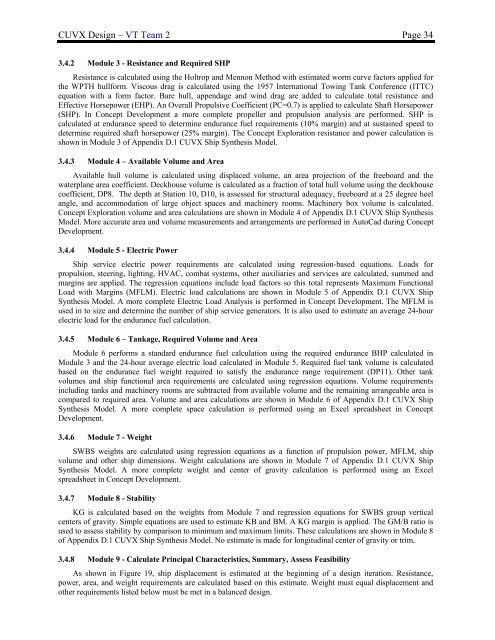CUVX Design Report - the AOE home page - Virginia Tech
CUVX Design Report - the AOE home page - Virginia Tech
CUVX Design Report - the AOE home page - Virginia Tech
Create successful ePaper yourself
Turn your PDF publications into a flip-book with our unique Google optimized e-Paper software.
<strong>CUVX</strong> <strong>Design</strong> – VT Team 2 Page 343.4.2 Module 3 - Resistance and Required SHPResistance is calculated using <strong>the</strong> Holtrop and Mennon Method with estimated worm curve factors applied for<strong>the</strong> WPTH hullform. Viscous drag is calculated using <strong>the</strong> 1957 International Towing Tank Conference (ITTC)equation with a form factor. Bare hull, appendage and wind drag are added to calculate total resistance andEffective Horsepower (EHP). An Overall Propulsive Coefficient (PC=0.7) is applied to calculate Shaft Horsepower(SHP). In Concept Development a more complete propeller and propulsion analysis are performed. SHP iscalculated at endurance speed to determine endurance fuel requirements (10% margin) and at sustained speed todetermine required shaft horsepower (25% margin). The Concept Exploration resistance and power calculation isshown in Module 3 of Appendix D.1 <strong>CUVX</strong> Ship Syn<strong>the</strong>sis Model.3.4.3 Module 4 – Available Volume and AreaAvailable hull volume is calculated using displaced volume, an area projection of <strong>the</strong> freeboard and <strong>the</strong>waterplane area coefficient. Deckhouse volume is calculated as a fraction of total hull volume using <strong>the</strong> deckhousecoefficient, DP8. The depth at Station 10, D10, is assessed for structural adequacy, freeboard at a 25 degree heelangle, and accommodation of large object spaces and machinery rooms. Machinery box volume is calculated.Concept Exploration volume and area calculations are shown in Module 4 of Appendix D.1 <strong>CUVX</strong> Ship Syn<strong>the</strong>sisModel. More accurate area and volume measurements and arrangements are performed in AutoCad during ConceptDevelopment.3.4.4 Module 5 - Electric PowerShip service electric power requirements are calculated using regression-based equations. Loads forpropulsion, steering, lighting, HVAC, combat systems, o<strong>the</strong>r auxiliaries and services are calculated, summed andmargins are applied. The regression equations include load factors so this total represents Maximum FunctionalLoad with Margins (MFLM). Electric load calculations are shown in Module 5 of Appendix D.1 <strong>CUVX</strong> ShipSyn<strong>the</strong>sis Model. A more complete Electric Load Analysis is performed in Concept Development. The MFLM isused in to size and determine <strong>the</strong> number of ship service generators. It is also used to estimate an average 24-hourelectric load for <strong>the</strong> endurance fuel calculation.3.4.5 Module 6 – Tankage, Required Volume and AreaModule 6 performs a standard endurance fuel calculation using <strong>the</strong> required endurance BHP calculated inModule 3 and <strong>the</strong> 24-hour average electric load calculated in Module 5. Required fuel tank volume is calculatedbased on <strong>the</strong> endurance fuel weight required to satisfy <strong>the</strong> endurance range requirement (DP11). O<strong>the</strong>r tankvolumes and ship functional area requirements are calculated using regression equations. Volume requirementsincluding tanks and machinery rooms are subtracted from available volume and <strong>the</strong> remaining arrangeable area iscompared to required area. Volume and area calculations are shown in Module 6 of Appendix D.1 <strong>CUVX</strong> ShipSyn<strong>the</strong>sis Model. A more complete space calculation is performed using an Excel spreadsheet in ConceptDevelopment.3.4.6 Module 7 - WeightSWBS weights are calculated using regression equations as a function of propulsion power, MFLM, shipvolume and o<strong>the</strong>r ship dimensions. Weight calculations are shown in Module 7 of Appendix D.1 <strong>CUVX</strong> ShipSyn<strong>the</strong>sis Model. A more complete weight and center of gravity calculation is performed using an Excelspreadsheet in Concept Development.3.4.7 Module 8 - StabilityKG is calculated based on <strong>the</strong> weights from Module 7 and regression equations for SWBS group verticalcenters of gravity. Simple equations are used to estimate KB and BM. A KG margin is applied. The GM/B ratio isused to assess stability by comparison to minimum and maximum limits. These calculations are shown in Module 8of Appendix D.1 <strong>CUVX</strong> Ship Syn<strong>the</strong>sis Model. No estimate is made for longitudinal center of gravity or trim.3.4.8 Module 9 - Calculate Principal Characteristics, Summary, Assess FeasibilityAs shown in Figure 19, ship displacement is estimated at <strong>the</strong> beginning of a design iteration. Resistance,power, area, and weight requirements are calculated based on this estimate. Weight must equal displacement ando<strong>the</strong>r requirements listed below must be met in a balanced design.
















